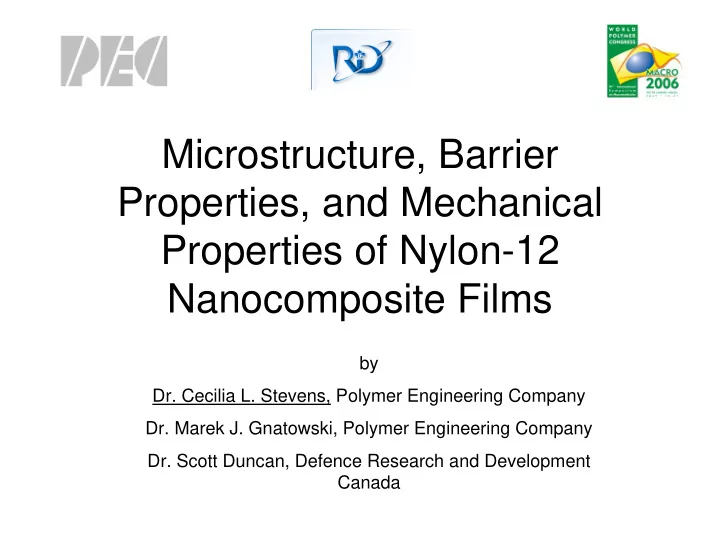

Microstructure, Barrier Properties, and Mechanical Properties of Nylon-12 Nanocomposite Films by Dr. Cecilia L. Stevens, Polymer Engineering Company Dr. Marek J. Gnatowski, Polymer Engineering Company Dr. Scott Duncan, Defence Research and Development Canada
Samples • Extruded films • 1.0 mil thick • 10% treated montmorillonite clay in nylon-12 • Various blending methods
Batch blending for 1 minute (B) REE 67 prep mixer with high-shear roller blades (W.C. Brabender)
Single-screw extrusion (C) 25mm extruder with mixing screw, L/D = 25 (W.C. Brabender)
Twin-screw extrusion with compounding screws (D) D6-2 counter-rotating twin-screw extruder, L/D = 6 (W.C. Brabender)
Twin-screw extrusion with standard screws (E) TSE 20mm co-rotating twin-screw extruder, L/D = 40 (W.C. Brabender)
Methods of Assessment • Physical – Mechanical properties • Stress • Strain • Young’s modulus – Barrier properties • Breakthrough time • Structural – TEM imaging • Platelet size • Platelet exfoliation – FTIR spectroscopy
Observed Platelet sizes (nm) A (100% nylon-12) N/A B (batch blended) 202 C (single-screw extrusion) 171 D (compounding twin-screw) 144 E (standard twin-screw) 111
Platelet exfoliation Batch blending (B)
Platelet exfoliation Single-screw extrusion (C)
Platelet exfoliation Compounding twin-screw (D)
Platelet exfoliation Standard twin-screw (E)
Mechanical properties Strain (%) 300 260 Strain (%) 220 180 140 100 100 120 140 160 180 200 220 Platelet size (nm)
Mechanical properties Ultimate tensile stress 90 Ulitmate tensile stress (MPa) 80 70 60 50 40 30 20 100 120 140 160 180 200 220 Platelet size (nm)
Mechanical properties Young’s modulus 2000 Young's Modulus (MPa) 1600 1200 800 400 0 100 120 140 160 180 200 220 Platelet size (nm)
Breakthrough time 16 e (h) 12 Breakthrough tim 8 4 0 100 120 140 160 180 200 220 Platelet size (nm)
FTIR spectroscopy 1.2 1 FTIR Peak Height 0.8 0.6 0.4 0.2 0 100 120 140 160 180 200 220 Platelet size (nm)
FTIR example spectrum Nylon-12 peak used for normalisation of FTIR spectra Silicate peak
Conclusions • Platelet size starts to decrease prior to full exfoliation. • Prior to full exfoliation, mechanical properties are not highly responsive to platelet size (completeness of exfoliation). • After exfoliation, elongation at break is directly dependent on platelet size. • After exfoliation, stress and Young’s modulus are not highly responsive to platelet size, although improved over non-exfoliated samples. • Barrier properties are inversely related to platelet size both before and after exfoliation. • FTIR may be responsive to nanoclay dispersion.
Acknowledgements Polymer Engineering Defence Research and Company Development Canada Dr. Marek Gnatowski Dr. Scott Duncan pecltd@telus.net Scott.Duncan@drdc-rddc.gc.ca David Lesewick Ben Lacroix Beverley Start W.C. Brabender University of British Andrew Yacykewych Columbia TEM Kim Rensing Suppliers Derrick Horne Nanocor EMS-Grivory
Recommend
More recommend